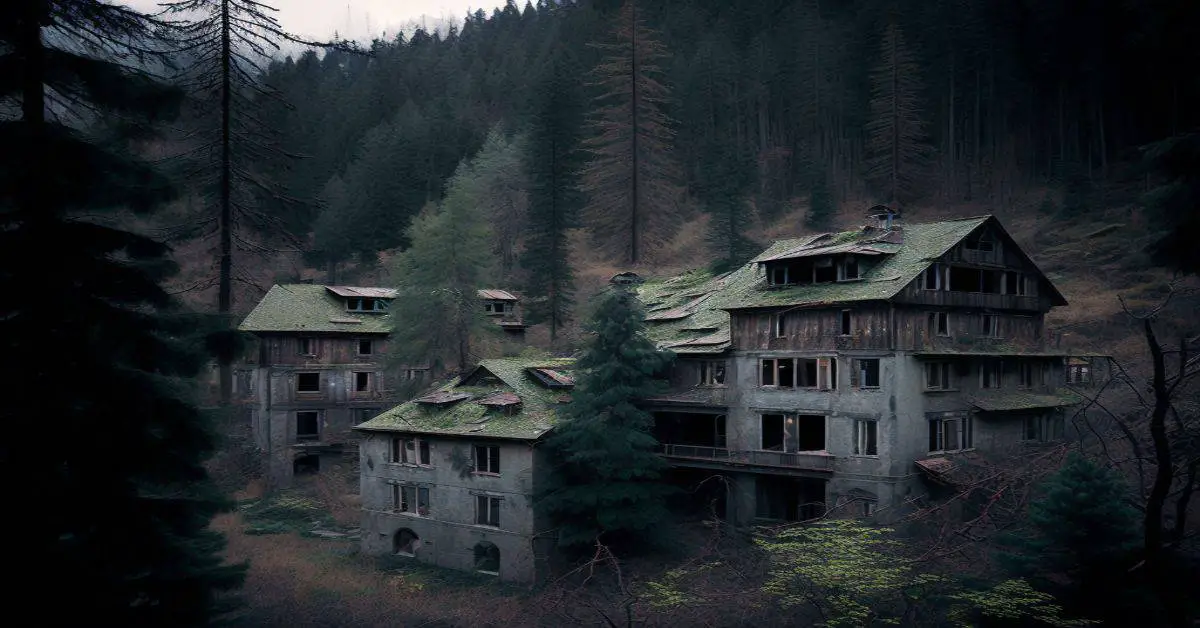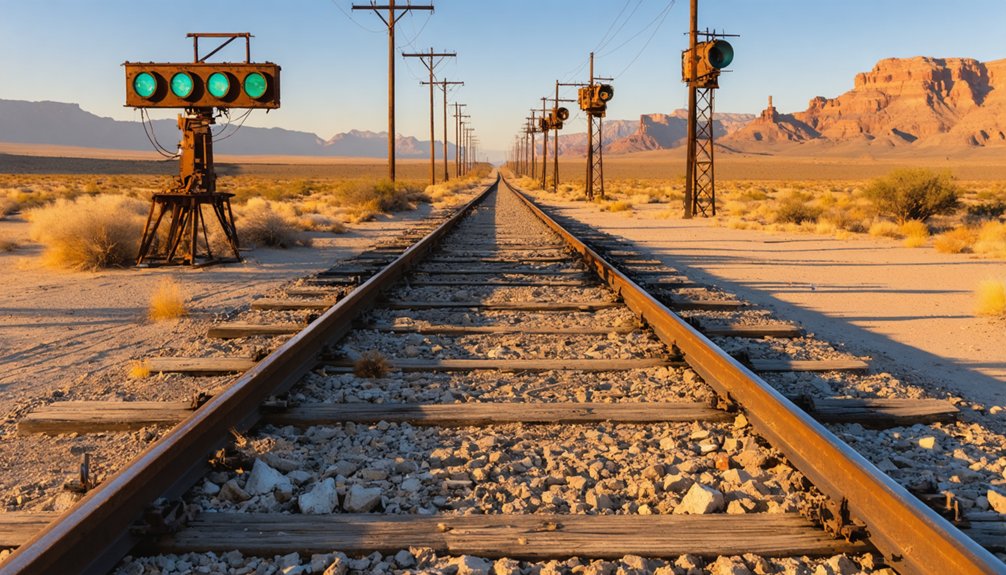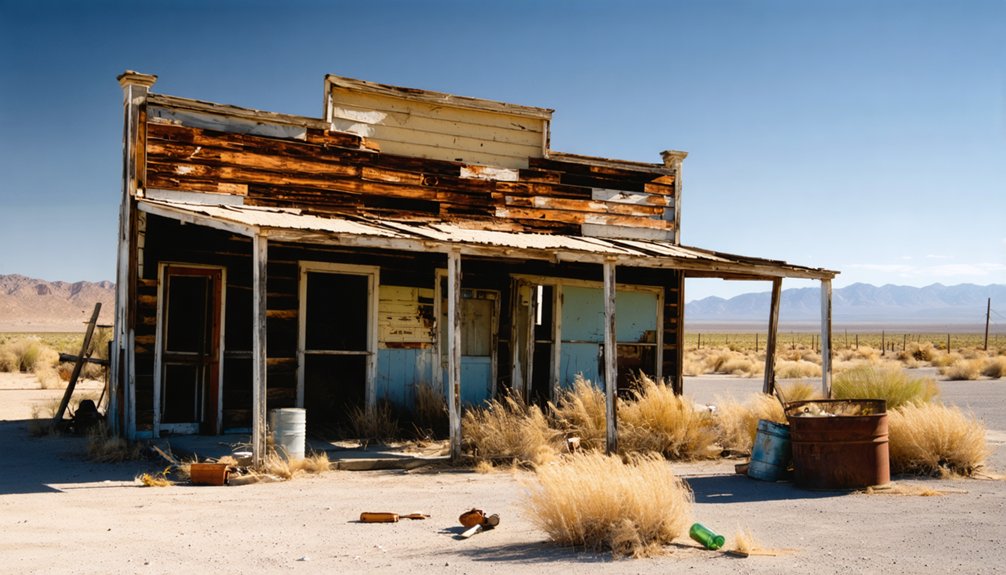Oro Blanco, established in 1873 after the discovery of silvery white placer gold, once thrived with over 50 homes, a school, and community activities. You’ll find this ghost town 25 miles from Nogales via State Highway 289. After the 1893 silver crash and eventual ore depletion, mining operations ceased by 1962, leaving abandoned shafts and equipment. The area’s mysterious legends include a mercantile allegedly built on a padre’s grave. The whisper-thin line between history and supernatural awaits.
Key Takeaways
- Oro Blanco was established in 1873 after silver-white placer gold discovery and grew to over 50 residences by the 1930s.
- The mining town declined after silver devaluation, ore depletion, and the post office closure in 1941.
- John “Yank” Bartlett developed the first productive mines and established the Tiger Mine, enhancing the district’s reputation.
- The Eagle-Picher Mining Company operated until 1948, with all mining activities ceasing by 1962.
- The ghost town is accessible via State Highway 289, approximately 25 miles from Nogales, Arizona.
The White Gold Discovery: Origins of a Mining District
Nestled in the rugged terrain north of the US-Mexico border, the Oro Blanco Mining District earned its distinctive name from the unusual silvery white placer gold that early prospectors discovered among its gulches and ravines.
You can trace its founding to around 1873, when pioneers uncovered rich gold veins despite Apache resistance and limited water supplies.
Early visionaries like Charles Poston and Henry Ehrenberg (1854) blazed trails that later miners would follow. Similar exploration occurred in what became Ruby, where American prospectors revived mining operations in 1854 after earlier Spanish expeditions.
Their primitive placer mining operations in Alamo and Warsaw Gulches used basic arrastras and hand tools, extracting ore from soil distinctively colored by decomposed pyrite.
This “white gold,” alloyed naturally with silver, presented unique challenges but promised freedom from ordinary life for those bold enough to seek it. Travelers can reach the historic mining district by traveling approximately 25 miles northwest from Nogales on State Highway 289, where dirt roads lead to these once-bustling placer areas.
John “Yank” Bartlett: A Pioneer’s Influence
You’ll find John “Yank” Bartlett’s fingerprints all over Oro Blanco‘s development, from establishing the district’s first productive mines in 1873 to surviving devastating Apache raids that threatened the settlement’s very existence.
His partnership with Henry Hewitt proved particularly fruitful, yielding the legendary Tiger Mine whose rich gold deposits cemented Oro Blanco’s mining reputation. Bartlett’s early mining efforts included setting up primitive arrastras to process the ore extracted from his claims. Born in New Hampshire, Bartlett fully embraced the frontier lifestyle after arriving in Arizona.
Even after his death in 1905, Bartlett’s legacy lives on through Yank’s Spring and the foundations of his ranch house that still mark the landscape of this once-thriving frontier community.
Bartlett’s Mining Leadership
Despite the rugged challenges of frontier mining, John “Yank” Bartlett emerged as the driving force behind the Oro Blanco district‘s development in the 1870s. His strategic vision was evident when he partnered with Hewitt, Dr. Handy, and Robert Leatherwood to establish the Ostrich mill on a mesa north of town, creating a central processing hub for the region’s rich gold ore.
You can trace Bartlett’s mining partnerships throughout the area – from the original Oro Blanco mine just miles from the Mexican border to the “Old Mine” west of town. The area was renowned for its lighter-colored gold deposits which gave the district its distinctive Spanish name. Much like John Kellner who managed successful business ventures in Globe and Phoenix, Bartlett understood the importance of strategic partnerships in frontier economies.
His collaboration with Hank Hewitt extended their influence into Sonora and included pack train services that became crucial infrastructure. Together, they transformed this borderland region, founding the town of “new” Oro Blanco that would become a beacon for prospectors seeking fortune in Arizona’s mineral-rich wilderness.
Apache Raid Aftermath
When the bloody aftermath of the 1886 Bear Valley Apache raid unfolded, John “Yank” Bartlett’s homestead became an unexpected focal point in one of the final chapters of the Apache Wars.
As U.S. Army pursuers tracked the raiders who’d killed four settlers—including a woman and infant—they picked up the trail near Bartlett’s strategic property.
The raid represented the intensifying Apache conflicts that threatened frontier settlements like Oro Blanco.
Captain Thomas Lebo’s 200-mile pursuit into Mexico following the deadly attack demonstrated the military’s determination to end such violence.
Though Geronimo denied leadership of the raid, attributing it to Naiche, the damage was done.
Bartlett’s continued presence amidst these dangers exemplified the settler resilience that characterized Arizona’s frontier communities despite ongoing threats to life and livelihood.
Yank Bartlett demonstrated remarkable bravery during the attack as he engaged the Apaches while simultaneously tending to Shanahan’s wound.
This conflict occurred during a period when many Apache communities had already been forced onto restrictive reservations following earlier violence like the Camp Grant Massacre.
Legacy Beyond Death
Though John “Yank” Bartlett’s life ended in 1905, his influence on Oro Blanco continued to ripple through the decades that followed.
When you explore the ghost town today, you’re witnessing Bartlett’s legacy in the very foundations of what once was a thriving mining district. He left behind not just a substantial estate but a family deeply embedded in the region’s business fabric, with descendants who operated hotels and stores well into the 20th century. His daughter Benigna “Mama Nina” Bartlett Valenzuela became an important figure in nearby Amado after marrying Francisco “Papa Kiko” Pasos Valenzuela and moving there in the early 1900s.
The mining infrastructure he established—particularly the Ostrich mill—transformed Oro Blanco into a regional hub that connected remote operations to larger markets.
His pioneering spirit and community resilience during Apache raids became woven into local folklore, immortalized in landmarks like “Yank’s Spring” that still bear his name today.
Silver Crash and Mining Operations Through the Years
The devastating silver crash of 1893 altered the fate of Oro Blanco forever, reshaping the once-thriving mining community into a landscape of abandoned dreams. When Congress repealed the Sherman Silver Purchase Act, silver prices plummeted, decimating mining profitability throughout Arizona.
You can trace Oro Blanco’s boom-and-bust cycle from its 1850 discovery through decades of transformation. Small-scale operations using arrastras and steam mills gave way to intermittent revivals. Mining operations focused on extracting fine-grained gold and silver from the northwest-trending fissure zones that characterized the site’s geology.
The 1930s brought renewed life when Eagle-Picher Mining Company extracted both silver and gold until 1948.
Ownership changed hands repeatedly as companies struggled against market volatility. The mine’s final chapter closed in 1962, leaving behind abandoned shafts and rusting equipment as silent witnesses to economic forces that dictate the freedom and fate of frontier towns.
Daily Life and Population Changes in Oro Blanco

Fluctuating alongside the fortunes of its mines, Oro Blanco’s population ebbed and flowed dramatically throughout its existence, peaking at approximately 1,200 residents during the Montana Mine’s heyday in the mid-1930s.
From its modest beginnings with just 96 inhabitants in 1902, the town grew into a vibrant community where miners worked around the clock. You’d have found over 50 residences, a school, and essential services like a store and infirmary.
Community activities centered around the dance hall, baseball fields, and Boy Scout meetings, creating a close-knit atmosphere despite the town’s isolation. Family dynamics revolved around mining schedules, with women maintaining homes while men labored underground.
After silver devaluation and ore depletion, the population dwindled until 1941, when the post office closure marked Oro Blanco’s shift to ghost town status.
Mysterious Legends: Curses and Haunted Structures
You’ll find that Oro Blanco’s most chilling legend centers on the mercantile building constructed atop a padre’s grave, where “Old Tio Pedro” supposedly cursed all who dared occupy the structure.
This supernatural claim gained credibility after two sets of owners met violent ends inside the building, beginning with the 1921 brutal murders of Frank and Myrtle Pearson by vaqueros who stole gold teeth from Myrtle’s mouth.
The curse seemed to validate itself when subsequent occupants also perished violently about a year later, fueling decades of whispers among locals who refused to approach the site after sundown.
Cursed Graves Below
While wandering through Oro Blanco’s weathered ruins, you’re treading on ground steeped in southwestern supernatural lore, though the town itself hasn’t garnered the same notorious reputation for curses as its neighbors.
Unlike Ruby, where cursed structures built over a padre’s grave triggered violent deaths and misfortune, Oro Blanco’s buildings stand relatively unburdened by such specific tales.
Yet you’re never far from the regional beliefs that permeate this borderland—where disturbing sacred ground risks awakening restless spirits bound eternally to the land.
The preservation efforts by descendants may have sheltered Oro Blanco from darker legends, but the whispers still echo through these hills.
Mexican superstitions and Apache warnings about the nearby Superstition Mountains remind you that in Arizona’s ghost towns, the line between history and the supernatural remains whisper-thin.
Padre’s Deadly Influence
Despite what regional folklore might suggest, Oro Blanco stands as an exception among Arizona’s ghost towns for its notable absence of a malevolent padre figure in its supernatural narrative.
Unlike neighboring mining settlements where padre legends often dominate local lore, the paranormal tales here focus primarily on the miners themselves.
You’ll find that supernatural themes in Oro Blanco stem from mining accidents, Apache conflicts, and frontier violence rather than clerical malfeasance.
When visiting the remaining structures—headframes and stamp mills—you might hear whispers of specters, but these apparitions typically manifest as fallen miners rather than vengeful clergy.
While religious artifacts occasionally surface among the ruins, they’ve inspired no documented stories of a priest’s deadly curse.
The haunting quality of Oro Blanco derives from its stark isolation and the harsh realities of frontier life.
The Noon Family Ranch: What Remains Today

Nestled about eight miles south of Arivaca, Arizona, the Noon Family Ranch stands as a confirmation to over a century of continuous family stewardship in the Oro Blanco region.
This living representation of ranch history began in October 1879 when Dr. Adolphus H. Noon and his son first established their ranching legacy in these rugged borderlands.
Today, you’ll find the ranch headquarters situated on Arivaca Road near milepost 18, occupying the former Proctor property.
The main residence sits proudly on a hill between historical Kinsley’s Ranch and Halfway Station.
Perched majestically on elevated ground, the main residence connects the storied landmarks of Kinsley’s Ranch and Halfway Station.
While exploring this area, you’ll witness the same landscapes that have sustained cattle operations since the early 1900s.
The Noon family’s dedication to preserving their heritage continues, maintaining the tradition of cattle raising that has defined this land for generations.
Frequently Asked Questions
Were Apache Attacks Common in the Oro Blanco Area?
Yes, you’d have found Apache raids quite common in Oro Blanco during the late 1800s. Local legends tell of frequent attacks that threatened settlers, especially during Geronimo’s War in 1886.
What Happened to the Original Church Built in Oro Blanco?
Ever wonder what remains of our past? The original church deteriorated as Oro Blanco’s population dwindled. You’ll find only ruins now—a silent reminder of its historical significance during the mining era.
Can Visitors Explore Any Remaining Mine Shafts Today?
No, you can’t legally explore the mine shafts today. They’re water-filled, collapsed, and strictly regulated by mine safety laws that protect you from deadly hazards lurking in these forbidden passages.
Did Any Famous Outlaws Operate in the Oro Blanco Region?
Yes, notorious outlaws haunted Oro Blanco during its mining history. You’ll find outlaw legends like Manuel Martinez and Silvas, who orchestrated the Ruby Murders and evaded one of Arizona’s largest manhunts.
How Did Residents Access Water in This Desert Mining Community?
Like drops of gold in a parched land, you’d rely on drywashing techniques when water was scarce, then celebrate when Eagle-Picher’s 15-mile pipeline from Santa Cruz River quenched your mining community’s thirst.
References
- https://www.legendsofamerica.com/az-ruby/
- https://southernarizonaconnectioncom.wordpress.com/2019/07/08/john-bartlett-founder-of-new-oro-blanco/
- https://www.destination4x4.com/tag/oro-blanco-mining-district/
- http://www.usa-ti.com/Arizona/Ghost_Towns/Ruby/brochures/2004_The_Private_Life_Of_Ruby-Mining_GhostTown.pdf
- https://www.youtube.com/watch?v=Q7IDauyYW7o
- https://www.ghosttowns.com/states/az/oroblanco.html
- https://www.rubyaz.com/history.html
- https://westernmininghistory.com/library/38005/page1/
- https://pubs.usgs.gov/bul/1355/report.pdf
- https://www.mindat.org/loc-32066.html



